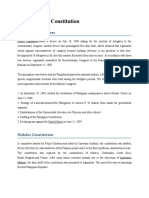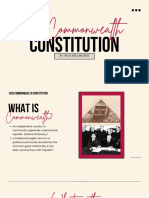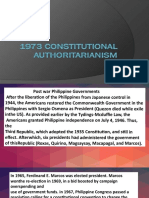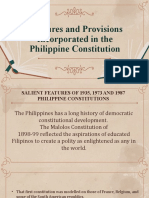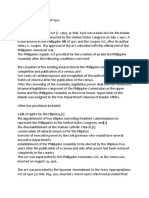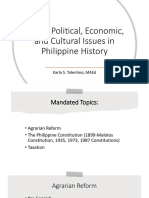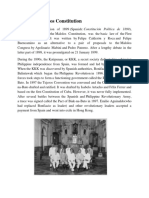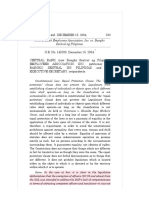0 ratings0% found this document useful (0 votes)
415 views1987 Constitution of Martial Law
1987 Constitution of Martial Law
Uploaded by
Sensei SenseiThe 1987 Constitution of the Philippines established a democratic republic with separation of powers among the executive, legislative, and judicial branches. It created checks on presidential power and outlined three methods for amending the Constitution.
Copyright:
© All Rights Reserved
Available Formats
Download as PPTX, PDF, TXT or read online from Scribd
1987 Constitution of Martial Law
1987 Constitution of Martial Law
Uploaded by
Sensei Sensei0 ratings0% found this document useful (0 votes)
415 views27 pagesThe 1987 Constitution of the Philippines established a democratic republic with separation of powers among the executive, legislative, and judicial branches. It created checks on presidential power and outlined three methods for amending the Constitution.
Original Description:
1987 Constitution Of Martial Law PPT
Original Title
1987 Constitution Of Martial Law PPT
Copyright
© © All Rights Reserved
Available Formats
PPTX, PDF, TXT or read online from Scribd
Share this document
Did you find this document useful?
Is this content inappropriate?
The 1987 Constitution of the Philippines established a democratic republic with separation of powers among the executive, legislative, and judicial branches. It created checks on presidential power and outlined three methods for amending the Constitution.
Copyright:
© All Rights Reserved
Available Formats
Download as PPTX, PDF, TXT or read online from Scribd
Download as pptx, pdf, or txt
0 ratings0% found this document useful (0 votes)
415 views27 pages1987 Constitution of Martial Law
1987 Constitution of Martial Law
Uploaded by
Sensei SenseiThe 1987 Constitution of the Philippines established a democratic republic with separation of powers among the executive, legislative, and judicial branches. It created checks on presidential power and outlined three methods for amending the Constitution.
Copyright:
© All Rights Reserved
Available Formats
Download as PPTX, PDF, TXT or read online from Scribd
Download as pptx, pdf, or txt
You are on page 1of 27
1987: Constitution
After Martial Law
After the Martial Law, President Corazon Aquino
was sworn to be the eleventh president of the
Philippines.
She had three option regrading the constitution;
- Revert the 1935 constitution
- Retain 1973 constitution
- Make a new constitution
In March 1986, President Aquino proclaimed a
transitional constitution to last for a year while
a Constitutional Commission drafted a
permanent constitution. This transitional
constitution, called the Freedom Constitution.
Maintained many provisions of the old one,
including in rewritten form the presidential
right to rule by decree.
In 1986, a constitutional convention was created,
composed of 48 members appointed by President
Aquino from varied backgrounds and representations.
The convention drew up a permanent constitution,
largely restoring the setup abolished by Marcos in
1972, but with new ways to keep the president in
check, a reaction to the experience of Marcos’s rule.
The new constitution was officially adopted on 2
February 1987.
The Constitution begins with a preamble and
eighteen self-contained articles. It established
the Philippines as a “democratic republican
State” where “sovereignty resides in the people
and all government authority emanates from
them.” It allocates governmental powers among
the executive, legislative, and judicial branches of
the government.
• The Executive branch is headed by the president and
his cabinet, whom he appoints. The president is the
head of the state and the chief executive. But his
power is limited by significant checks from the two
other co-equal branches of government, especially
during times of emergency.
In cases of national emergency, the president
may still declare martial law, but not longer than
a period of sixty days. Congress, through a
majority vote, can revoke this decision, or extend
it for a period that they determine.
The Supreme Court may also review the
declaration of martial law and decide if there were
sufficient justifying facts for the act.
The president and the vice president are elected
at large by a direct vote, serving a single six-year
term.
The legislative power resides in a Congress
divided into two Houses: the Senate and the
House of Representatives. The 24 senators are
elected at large by popular vote, and can serve
no more than two consecutive six year terms.
The House is composed of district representatives
representing a particular geographic area and
makes up around 80% of the total number of
representatives. There are 234 legislative districts
in the Philippines that elect their representatives
to serve three-year terms.
The 1987 Constitution created a party-list system
to provide spaces for the participation of under
represented community sectors or groups. Party-
list representatives may fil up not more than 20%
of the seats in the House.
Aside from the exclusive power of legislation,
Congress may also declare war, through a two-
thirds vote in both upper and lower houses. The
power of legislation, however, is also subject to
an executive check, as the president retains the
power to veto or stop a bill from becoming a law.
Congress may only override this power with a
two-thirds vote in both houses.
The Philippine Court system is vested with the
power of the judiciary and is composed of a
Supreme Court and lower courts as created by
law. The Supreme Court is a 15-member court
appointed by the president without the need to
be confirmed by Congress.
The Supreme Court Justices may hear, on
appeal, any cases dealing with the
constitutionality of any law, treaty, or decree of
the government, cases where questions of
jurisdiction or judicial error are concerned, or
cases where the penalty is sufficiently grave.
It may also exercise original jurisdiction over
cases involving government or international
officials. The Supreme Court is also in charge of
overseeing the functioning and administration
of the lower courts and their personnel
The Constitution also established three independent
Constitutional Commissions, namely,
• The Civil Service Commission, a central agency in charge
of government personnel;
• The Commission on Elections, mandated to enforce and
administer all election laws and regulations;
• And the Commission on Audit,which examines all funds,
transactions, and property accounts of the government
and its agencies.
Changing the Constitution
It is a perennial issue that crops up, and terms
such as “Cha-Cha,” “Con-Ass,” and “Con-Con”
are regularly thrown around. Article XVII of
the 1987 Constitution provides for three ways
by which the Constitution can be changed.
Charter change (Cha-Cha)
• Refers to the political and legal processes
needed to amend the current 1987
Constitution of the Philippines.
Constituent Assembly (Con-Ass)
Congress (House of Representatives and the
Senate) may convene as a Con-Ass to propose
amendments to the Constitution. It is not clear,
however, if Congress is to vote as a single body or
separately. How the Congress convenes as a Con-
Ass is also not provided for in the Constitution.
Constitutional Convention (Con-Con)
• Another method is through the Con-Con. Where
Congress, upon a vote of two-thirds of all its
members, calls for constitutional convention.
They may also submit to the electorate the
question of calling a convention through a
majority vote of all its members.
In a Con-Con, delegates will propose
amendments or revisions to the constitution,
not Congress. The 1987 Constitution does not
provide for a method by which delegates to the
Con-Con are chosen.
“People’s Initiative” (or PI).
• In this method, amendments to the
Constitution may be proposed by the
people upon a petition of at least 12% of
the total number of registered voters.
The 1987 Constitution directs the Congress to
enact a law to implement provisions of the PI,
which has not yet materialized.
Amendments or revision to the constitution shall
be valid only when ratified by a majority of the
votes cast in a national referendum.
Only the House of Representatives can initiate the
impeachment of the president, members of the
Supreme Court, and other constitutionally
protected public officials such as the
Ombudsman. The Senate will then try the
impeachment case. This is another safeguard to
promote moral and ethical conduct in the
government.
You might also like
- UNESCO HR Manual ENG PDFDocument836 pagesUNESCO HR Manual ENG PDFAsaadalfaqeh100% (2)
- Philippine History & GovernmentDocument130 pagesPhilippine History & GovernmentCarlos Baul David0% (2)
- The 1987 Constitution After Martial LawDocument13 pagesThe 1987 Constitution After Martial LawFaith Ann CortezNo ratings yet
- Quiz (1973 Phil. Constitution)Document3 pagesQuiz (1973 Phil. Constitution)Desiree Calpito100% (1)
- History of Political Parties in The PhilippinesDocument9 pagesHistory of Political Parties in The PhilippinesKurt Ryan Jesura100% (1)
- 1899: Malolos ConstitutionDocument4 pages1899: Malolos ConstitutionNeil Patrick OrdoñezNo ratings yet
- 020 - Francisco v. Toll Regulatory BoardDocument5 pages020 - Francisco v. Toll Regulatory Boardjacaringal1No ratings yet
- 1987: Constitution After Martial LawDocument2 pages1987: Constitution After Martial LawNatalieNo ratings yet
- 1935 Commonwealth ConstitutionDocument23 pages1935 Commonwealth ConstitutionJuhany Musa100% (1)
- 1973 Constitutional AuthoritismDocument16 pages1973 Constitutional AuthoritismErica HerreraNo ratings yet
- Lesson 10 The Tejeros ConventionDocument30 pagesLesson 10 The Tejeros ConventionMark Joseph PresasNo ratings yet
- SALIENT FEATURES and PROVISIONSDocument17 pagesSALIENT FEATURES and PROVISIONSJulliana MayNo ratings yet
- 1973 ConstitutionDocument9 pages1973 ConstitutionBJ AmbatNo ratings yet
- THE EVOLUTION OF PHILIPPINE CONSTITUTIONsDocument39 pagesTHE EVOLUTION OF PHILIPPINE CONSTITUTIONsMo PadillaNo ratings yet
- THE 1935 Constitution: Yannel M. VillaberDocument12 pagesTHE 1935 Constitution: Yannel M. VillaberYannel Villaber100% (1)
- 1897 Constitution of Biak-na-BatoDocument8 pages1897 Constitution of Biak-na-BatoCara Delatuh0% (1)
- Article V: Suffrage: National Service Training Program 2 Southville International School and CollegesDocument15 pagesArticle V: Suffrage: National Service Training Program 2 Southville International School and CollegesKeaneNo ratings yet
- 1935 CONSTITUTION - Dacumos and ValdezDocument20 pages1935 CONSTITUTION - Dacumos and ValdezBJ AmbatNo ratings yet
- Module 12 Global DividesDocument26 pagesModule 12 Global DividesRylee DungcaNo ratings yet
- Philippine AssemblyDocument3 pagesPhilippine AssemblyJerome EncinaresNo ratings yet
- The Constitution of The Philippine CommonwealthDocument11 pagesThe Constitution of The Philippine CommonwealthBJ AmbatNo ratings yet
- The 1935 ConstitutionDocument1 pageThe 1935 ConstitutionLuna Capit100% (1)
- 1935 ConstitutionDocument25 pages1935 ConstitutionJustine BayhonNo ratings yet
- List of Philippine Presidents and Their ContributionsDocument4 pagesList of Philippine Presidents and Their ContributionsMelchie Repospolo100% (1)
- Accomplishments of Marcos During His PresidencyDocument5 pagesAccomplishments of Marcos During His PresidencyPhoebe AradoNo ratings yet
- What Is A Constitution?: Constitutional Authoritarianism Constitution After Martial LawDocument4 pagesWhat Is A Constitution?: Constitutional Authoritarianism Constitution After Martial LawRob CatayloNo ratings yet
- The 1973 Constitutional AuthoritarianismDocument4 pagesThe 1973 Constitutional AuthoritarianismFaith Ann Cortez100% (1)
- The 1935 Constitution of The PhilippinesDocument3 pagesThe 1935 Constitution of The Philippinesbrenda100% (1)
- Discuss The Tragic Experiences of The Filipinos in The Hands of The Spaniards As Mentioned in The DocumentDocument2 pagesDiscuss The Tragic Experiences of The Filipinos in The Hands of The Spaniards As Mentioned in The DocumentMarian Grace BalladaresNo ratings yet
- 1973 ConstitutionDocument13 pages1973 ConstitutionLea BualeNo ratings yet
- The 1973 ConstitutionDocument23 pagesThe 1973 ConstitutionDayNo ratings yet
- The Constitution of The Philippine CommonwealthDocument3 pagesThe Constitution of The Philippine Commonwealtheydel_beeNo ratings yet
- Lesson 2.2 Kartilya NG KatipunanDocument4 pagesLesson 2.2 Kartilya NG Katipunanlzlie RbsraNo ratings yet
- Philippine HistoryDocument2 pagesPhilippine HistoryCandice Bolay-ogNo ratings yet
- The Commonwealth Period of The PhilippinesDocument26 pagesThe Commonwealth Period of The PhilippinesDanica VillaflorNo ratings yet
- Module 3 Unit 3 Constitution of The PhilippinesDocument19 pagesModule 3 Unit 3 Constitution of The PhilippinesKaya StormNo ratings yet
- 1986 Freedom ConstitutionDocument4 pages1986 Freedom ConstitutionIrin200100% (2)
- Women in The American PeriodDocument2 pagesWomen in The American PeriodZaima L. GuroNo ratings yet
- Agrarian Reform During The Administration of Macapagal, Marcos, and Corazon AquinoDocument19 pagesAgrarian Reform During The Administration of Macapagal, Marcos, and Corazon AquinoMatrix100% (1)
- The 17 Presidents and Their LegaciesDocument8 pagesThe 17 Presidents and Their LegaciesErvin Tolentino100% (1)
- 1935 Constitution FinalDocument14 pages1935 Constitution Finaljohnlloyd delarosaNo ratings yet
- Evolution of The Philippine Constitution: Learning ObjectivesDocument30 pagesEvolution of The Philippine Constitution: Learning ObjectivesEvarish CarmonaNo ratings yet
- Philippine Organic Act of 1902Document5 pagesPhilippine Organic Act of 1902Lizza AlipioNo ratings yet
- The Declaration of Martial Law: Proclamation No. 1081Document17 pagesThe Declaration of Martial Law: Proclamation No. 1081Cherry Mae Morales BandijaNo ratings yet
- Salient FeaturesDocument3 pagesSalient FeaturesElla Qui65% (26)
- 1973 Martial Law ConstitutionDocument13 pages1973 Martial Law ConstitutionIka PinkNo ratings yet
- Social Political Economic and Cultural Issues in Philippine HistoryDocument14 pagesSocial Political Economic and Cultural Issues in Philippine HistoryMichael AngelesNo ratings yet
- 8 Carper-And-The-Future-Of-Agrarian-Reform-In-The-Philippines-Group-8Document5 pages8 Carper-And-The-Future-Of-Agrarian-Reform-In-The-Philippines-Group-8Random internet person100% (1)
- Political History of The PhilippinesDocument13 pagesPolitical History of The PhilippinesTemoteo L. Pupa IIINo ratings yet
- Act of Declaration of IndependenceDocument67 pagesAct of Declaration of IndependenceGerard Byron Jacildo100% (1)
- Background and History of Liliosa HilaoDocument3 pagesBackground and History of Liliosa HilaoReychel Luna100% (1)
- The Government During The American RegimeDocument2 pagesThe Government During The American RegimeSonny Magluyan Fernandez100% (1)
- Assessment 4Document2 pagesAssessment 4Jeandra VillanuevaNo ratings yet
- The 1899 Malolos ConstitutionDocument5 pagesThe 1899 Malolos ConstitutionShenne MinglanaNo ratings yet
- The Malolos Constitution PreambleDocument3 pagesThe Malolos Constitution PreambleTori Peige100% (1)
- TaxationDocument5 pagesTaxationThonieroce Apryle Jey Morelos100% (1)
- Unit Ii Citizenship Training: Answer: My Responsibility As ADocument12 pagesUnit Ii Citizenship Training: Answer: My Responsibility As ALeonila GaboyNo ratings yet
- Hare - Hawes - Cutting ActDocument14 pagesHare - Hawes - Cutting ActGee Lee100% (1)
- CitizenshipDocument37 pagesCitizenshipNoel IV T. Borromeo100% (2)
- 1935 ConstitutionDocument11 pages1935 ConstitutionBJ AmbatNo ratings yet
- Citizenship Training Week 4Document5 pagesCitizenship Training Week 4missmoh85100% (1)
- 1987 Constitution of Martial LawDocument27 pages1987 Constitution of Martial LawSensei SenseiNo ratings yet
- Constitutional MoralityDocument7 pagesConstitutional MoralityRohit KumarNo ratings yet
- LESSON-1-Types-of-Govt-How-Govt-is-Formed (Part 4)Document22 pagesLESSON-1-Types-of-Govt-How-Govt-is-Formed (Part 4)Dee Cyree RusiaNo ratings yet
- Q1 - LAS 3 - Philippine Politics and GovernanceDocument8 pagesQ1 - LAS 3 - Philippine Politics and GovernanceElio SanchezNo ratings yet
- Case Digest Phil Blooming Mills Employees V Phil Blooming MillsDocument3 pagesCase Digest Phil Blooming Mills Employees V Phil Blooming MillsQuake G.100% (2)
- Ormoc Sugar Central v. Ormoc CityDocument2 pagesOrmoc Sugar Central v. Ormoc CityAnonymous HWfwDFRMPsNo ratings yet
- The Indian Constitution: (Page No. 17 of Your SPL Textbook)Document2 pagesThe Indian Constitution: (Page No. 17 of Your SPL Textbook)Sharad MusaleNo ratings yet
- Public Administration in Africa - Performance and Challenges (PDFDrive)Document237 pagesPublic Administration in Africa - Performance and Challenges (PDFDrive)Scott Dior100% (1)
- Teoria Dos Principios HUMBERTO AVILA PDFDocument45 pagesTeoria Dos Principios HUMBERTO AVILA PDFElton Frank100% (1)
- Legislative Power: What Is It?Document6 pagesLegislative Power: What Is It?Sally FetouhNo ratings yet
- Isagani Cruz & Cesar Europa V. Secretary of Environment and Natural ResourcesDocument8 pagesIsagani Cruz & Cesar Europa V. Secretary of Environment and Natural ResourcesRica AndreaNo ratings yet
- Date-Baah, Jurisprudence Day in CourtDocument10 pagesDate-Baah, Jurisprudence Day in CourtLaura winnsNo ratings yet
- IAL LAW Chapter 2 English Legal SystemDocument7 pagesIAL LAW Chapter 2 English Legal SystemRownak MahabubNo ratings yet
- Conl5112 MoDocument57 pagesConl5112 Mobradleyvanrensburg06No ratings yet
- Moot Court CompetitionDocument5 pagesMoot Court CompetitionVikki AmorioNo ratings yet
- Narendra Chapalgaonker - Subhashchandra Wagholikar (Transl.) - Mahatma Gandhi and The Indian Constitution-Routledge India (2015)Document145 pagesNarendra Chapalgaonker - Subhashchandra Wagholikar (Transl.) - Mahatma Gandhi and The Indian Constitution-Routledge India (2015)K RajNo ratings yet
- Socrates v. Commission On ElectionsDocument3 pagesSocrates v. Commission On ElectionsNoreenesse SantosNo ratings yet
- Consti Art Viii Sec 11 (E)Document12 pagesConsti Art Viii Sec 11 (E)Gretchen Dominguez-ZaldivarNo ratings yet
- Control Power Free Telephone Workers Union vs. OpleDocument4 pagesControl Power Free Telephone Workers Union vs. OplejohnmiggyNo ratings yet
- COCOFED vs. Republic, GR Nos. 177857 58, January 24, 2012Document5 pagesCOCOFED vs. Republic, GR Nos. 177857 58, January 24, 2012Kristina GomezNo ratings yet
- Finance Department Notification-2004 (205-258)Document54 pagesFinance Department Notification-2004 (205-258)Humayoun Ahmad Farooqi67% (6)
- Puboff de Leon ReviewerDocument68 pagesPuboff de Leon ReviewerStela PantaleonNo ratings yet
- 21 Central Bank Employees Association v. Bangko SentralDocument312 pages21 Central Bank Employees Association v. Bangko SentralKriszan ManiponNo ratings yet
- Boy Scouts of The Philippines v. NLRC, 196 SCRA 176 (1991)Document9 pagesBoy Scouts of The Philippines v. NLRC, 196 SCRA 176 (1991)inno KalNo ratings yet
- Why Doesn't The UK Have A Written Constitution, and Does It MatterDocument4 pagesWhy Doesn't The UK Have A Written Constitution, and Does It MatterCatalin Pop100% (2)
- The Foreign Sovereign Immunity Act of 2014Document9 pagesThe Foreign Sovereign Immunity Act of 2014Government of The United States of America100% (13)
- DC Wadhwa V. State of Bihar: A Halt To The Limitless Repromulgation of OrdinancesDocument12 pagesDC Wadhwa V. State of Bihar: A Halt To The Limitless Repromulgation of OrdinancesJai prakash keshriNo ratings yet
- Roles and Responsibilities in Rural Local Governance in ZimbabweDocument44 pagesRoles and Responsibilities in Rural Local Governance in ZimbabweTanaka Negarie Tk MoyoNo ratings yet
- Admin ElmanDocument90 pagesAdmin Elmanadonis.orillaNo ratings yet





